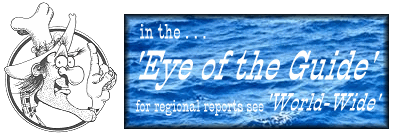The scene was all too familiar to me: an angler looked
at the fish he had just caught with disdain. He looked
around to see how far the bank was and decided he could
reach it. He threw the fish, a Goldeye, onto the bank
and resumed his fishing.
This type of a fisherman seems to be quite typical for
our area. If the fish he or she catches isn't the proper
species, he or she kills it. The term that many give to
these unwanted fish is "trash fish." Whatever they are
called, it rankles me that a person can kill fish without
using them.
Let's look at this phenomenon from a different perspective,
first of all, through the eyes of a youngster. On Saturday
I had the pleasure of guiding a young fellow, Henry Batty,
of Sheridan, Wyoming.
Henry had had a long day fly-fishing but with no success.
Though he had hooked a couple of trout, they had escaped.
I maneuvered my drift boat into a hole and pulled ashore.
I noticed some fish rising to the tan caddis that were
hatching so I switched Henry's rig from a nymph to a
dry fly, an elk hair caddis.
Henry started casting to the fish, but he soon lost heart
and wanted me to put the nymph rig back, but I advised
him to stick with it for a few more casts. About five
casts later, a fish rose to the fly. Henry set the hook
and started reeling. He was consumed with excitement
and joy; he had a fish on the end of the line.

After a twenty second tussle, I netted a 14-inch Goldeye.
Henry shouted, gave me a "high five" and begged his father,
Hugh, to take a photo of his fish. After several photos,
Henry released the Goldeye, and resumed fishing with
renewed enthusiasm and confidence.
Henry managed to land three trout - two rainbows and a
brown - from the pool, but I doubt he would have
persevered had he not caught the Goldeye. That fish
made the trip for him and turned an unsuccessful day
into a very successful one.
Another example of the value of a "trash fish" involves
the day I guided a blind fellow on the Snake River many
years ago. The fellow operated a spinning outfit quite
well. I had rigged it up with a Mepps spinner and
whenever I came into a large hole, I would instruct him
to cast to the right or left and retrieve the lure.
Over the course of the day, the fellow caught five or
six Whitefish - fish that were reviled by local anglers - but
the fish that had blessed him by taking his lure awed this
fellow.
He would say, "tell me about this fish, describe it, please.
Let me touch it."
I would comply and describe the Whitefish, then hold it
so that he could stroke it and feel it. He would reply,
"beautiful, beautiful."
I really think that we need to look at our fish through
the eyes of a youngster and the senses of a blind person.
When we do, we might realize that the trash fish is not
worthless. It has value and should be treated with respect.
I cannot imagine God, after creating the universe and all
the plants and animals that inhabit the world, saying,
"That's good, except for the trash fish."
Many anglers who wouldn't think of killing a trout and
are imbued with catch and release principles don't treat
other species the same way. What happened to catch and
release for Whitefish or Goldeye?
If you insist on killing non-trout species, at least make
use of them. Whitefish and Goldeye are excellent to eat
when they are smoked. In Alberta and Saskatchewan, smoked
Goldeye are priced the same as Walleye.
My mother used to send me out in the springtime to catch
Carp specifically for fertilizer for our tomato plants.
Those Carp grew some of the healthiest, and biggest
tomatoes that I have ever seen.
My cat loves to eat boiled Suckers, stunted Perch, and
Sunfish. My dogs like boiled fish, too.
One question for trash fish killers: what do you hope
to accomplish by killing them? You are not going to
eliminate them from the drainage. Most fish species
are so prolific that a single pair can produce hundreds
of thousands of offspring. Killing a few won't help.
You would need to kill darned near every trash fish
in the stream to have an effect.
You should also consider the stink and health hazard
you create. You probably won't want to fish in the
same spot two or three days after you tossed those
fish onto the bank.
Look at the fish that is on the end of the line as
the biggest and best fish you have on at the moment.
Just like a child gets excited over a fish on the
line, you should, too. Look at the trash fish as
a child or a blind person and you might realize
that the trash fish has lots of value.
~ Bob Krumm
About Bob:
Bob Krumm is a first-class guide who specializes on fishing the Big Horn River in Montana,
(and if there terrific fishing somewhere else he'll know about that too.) Bob has
written several other fine articles for the Eye Of The Guides series. He is also
a commericial fly tier who owns the Blue Quill Fly
Company which will even do your custom tying! You can reach him at:
1-307-673-1505 or by email at:
rkrumm@fiberpipe.net
|



